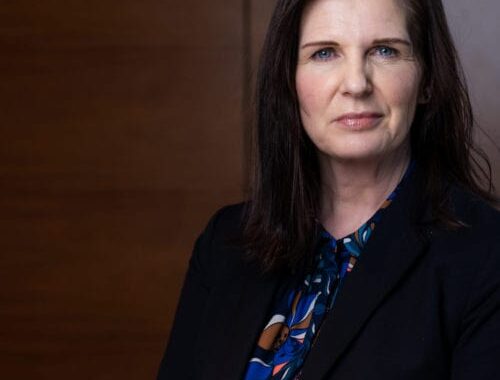
I Was Always a Radical Behaviourist: Blog Written by Yvonne Barnes-Holmes
Piece featured on ABAI blog.
I never believed I would go to University. None of my 10 siblings, nor any family relation I had ever known had ever been there, so I had no reason to want to go. But, at the same time, I knew that I saw the world differently from my family and friends and from as young as age six, I somehow believed this would be my ticket out of a difficult environment. There wasn’t a single book in our house, so when I won a scholarship to the local private grammar school at 11, I was undoubtedly the only student who saw Chaucer and Shakespeare as gifts. When my beloved sister (now deceased) was struggling with alcohol and three young children who needed to be looked after, I couldn’t see any way in which leaving my home town in troubled Northern Ireland and going to University resembled anything like an option. I was racked with confusion and guilt the day my career counselor convinced me to fill out the application form for college.
In the first few months of psychology at Manchester University, I was already disappointed at what I can only describe now as ‘mainstream thinking’. I stumbled across a Thomas Szasz book in a second-hand bookstore and my understanding of psychological suffering blossomed in the two days I poured over The Myth of Mental Illness. It may have resonated with my radical side of growing up in violence and political strife or with my experiences as a poor Irish student struggling against what felt like a sanitized version of psychology at an English University for middle-class people. Whichever it was, my frustration at why Szasz wasn’t on any of psychology’s reading lists was nothing short of painful. With a combination of ill-health and disillusionment, I left Manchester at the end of my second year and sought a transfer to Ulster University, so I could be near home. When the Head of Department, Julian Leslie, offered me a place in Psychology Year 3, he told me in a curious Oxford voice that the Department hadn’t had many disadvantaged students like me. A few days later I learned that I was to be sent to work as a research intern in the behavior analysis lab at the Coleraine campus because all of the other placements had already been agreed.
I turned up at the lab on a naïve Monday morning and they laughed openly at how the psychology I had learned was dominated by mainstream cognitive thinking. Because I secretly admired their devotion to what I thought at the time was ‘the simplistic psychology of rats and pigeons’, and because I wasn’t wedded to mainstream cognitive thinking anyway, I promised myself I would rise to any intellectual challenge they set me. Indeed, that challenge came in the second week when they gave me a copy of Vicki Lee’s Beyond Behaviorism, which I was to read in full and provide a summary at the lab meeting on the following Friday. Whilst I was almost feverish as the book challenged every single thing I learned about psychology in the two years previous, it somehow reminded me of Szasz. As the youngest of 11 children, I have a fundamental pack mentality and I now knew that this was my intellectual pack. The next book challenge they set me was Skinner’s About Behaviorism. By the end of that challenge, I knew I would be a behavioral psychologist for the rest of my life. And unbeknown to me, I had already met my future husband Dermot Barnes. In the eight months that followed he taught me everything he knew about behavior analysis and we wrote a paper that was published in 1991 in The Psychological Record. When my internship ended the following Summer, I did my final year at the Belfast campus. Work at that time was hard to find in Northern Ireland and like everyone else I went to England again. In no time at all, I had a young child of my own to look after and the promise of Skinner’s world seemed far away.
Back in Northern Ireland, it was a moment of sheer desperation one day when I contacted Mickey Keenan at Coleraine who thereafter kindly agreed to take me on as a Ph.D. student. I devoured Lovaas and everything that linked Applied Behavior Analysis (ABA) to the treatment of autism. But, in the months that followed my second child was born and my dreams of a return to behaviorism were slowly shattering. It was sheer chance that I decided, in the midst of a painful separation battle, to attend the annual meeting of Behavior Analysis in Ireland (BAI) in Galway that Spring. I felt a spark of life again when I gave a paper on ABA and autism, and met Dermot (also recently separated) once again. Although it will undoubtedly seem hasty to you the reader, when he asked me to marry him that evening (without having had any contact in almost eight years), I instantly agreed and we became Yvonne and Dermot Barnes-Holmes.
I moved to Cork within months and transferred my Ph.D. to the university there. Just as he had done before, Dermot set me one final challenge. On my very first day at the university, he told me that if we were to work together, I would “have to get on board with RFT” (Relational Frame Theory). I had only vaguely heard about the theory, but I totally trusted that if Dermot believed in it, it must be 100% behavioral. He gave me the 1989 edited book by Steve Hayes on rule-governed behavior, with the instruction to read the Hayes and Hayes chapter “The Action of the Listener as a Basis for Rule-goverance”. We planned to meet and discuss it over lunch. Once again, I was inspired by the challenge. And as I read those pages, I got an electrifying glimpse of what a world of integrating Szasz and Skinner might actually look like.
It was my poor mental health at that time that drew my focus from autism and ABA to Acceptance and Commitment Therapy (ACT). I learned everything I could about ACT, and Dermot and I worked together to use ACT to help me through my emotional struggles. Whilst it utterly transformed my personal life, I was always half-hearted about ACT’s scientific basis and genuinely couldn’t see how it connected to RFT. In the years that passed between 1998 and 2014, I devoted my academic career to RFT and one day every week to learning ACT, giving trainings, and seeing clients. During those years, I had a deep sense that both were revolutionary but the lack of integration between ACT and RFT haunted me.
After publishing over 150 articles and book chapters, and giving over 500 workshops and talks, I have never been so convinced of the merits of behavioral science as laid out by my intellectual fore bearers. There are so many people whose knowledge, kindness, and even criticisms shaped me in so many ways. Carmen Luciano, Mike Dougher, and Robyn Walser jump out specifically, but there are many more. What I took away from all of my fore bearers was an enduring belief that behavioral science would one day explain human complexity and psychological suffering. And in behavioral science, once you have prediction, it will always give you influence, if you stay close to the floor of the experimental laboratory. Indeed, one of the published works of which I am most proud is the chapter on scientific ambition in the Wiley Handbook of Contextual Behavioral Science.
My journey on the parallel paths of RFT and ACT came to a crossroads in 2014. My clinical work was showing me gaps in both. Clinically, there were places I needed to take my clients but my ACT interventions could not get me there. Scientifically, there were complexities in my clients’ behavior that I could not fully account for with what we knew then in RFT. And Ciara McEnteggart’s Ph.D. (which I supervised), and her group facilitation work on psychosis, were the straw that broke the camel’s back for me. I simply knew that neither ACT nor RFT could fully account for what those individuals experienced.
That year, my frustration at the widening gap between RFT and ACT spilled over at the ACBS conference and I began what I have since called the ‘middle level term crisis’. I realized at that time that I could no longer pretend that there was any substantive link between RFT and ACT. And I felt I should use my seniority in the field to be open and honest about this fact. I was very explicit about the short falls in ACT that had emerged from the rampant growth of middle level terms. I was equally explicit about shortfalls in RFT that limited fully and directly applying the theory to psychotherapy. I knew well that the crisis would be painful, and potentially fractious within the ACT-RFT community. But for me, the cost of softening the functionality of RFT (which is what I saw happening) was never an option, and my ambition for an entirely behavioral science approach to human complexity and suffering grew stronger in spite of reactions from my peers. I started to feel like an outcast and that really hurts a pack animal like me.
Now I saw my pack as Dermot and our students, post-docs and other colleagues who also had become frustrated with the lack of clear lines of connection between ACT and RFT. The scientific choice was to either keep RFT static and avoid challenging the ACT-RFT community or develop RFT and potentially go it alone. The clinical choice was to avoid challenging ACT orthodoxy or to develop ACT by aligning it more closely with what developing RFT might look like. Dermot and I both knew what each would choose. In 2015, Dermot was awarded a large Belgian grant in principle to try to align RFT and ACT. We used the time and money in the best way we knew how and as we developed RFT, its putative links with ACT appeared to become increasingly tenuous. During our time in Gent, Ciara (McEnteggart) and I spent countless weekends on the move around Belgium translating what we were learning about RFT into clinical work and training. Weekend after weekend, we could see how our clinical ideas were being changed by every RFT conversation and data point we had seen in the lab that week. It was an incredibly exciting, but simply exhausting, time for us both. And by the end of the grant, Process-Based Behavior Therapy (PBBT) had come to be born. In truth, creating a new form of behavior therapy was never in our plans. But it was clear from the first day we heard the word ROE (as the basic response unit of arbitrarily applicable relational responding) that Dermot had changed RFT fundamentally and forever. We knew it was a clinical game changer and we decided to trust it.
There was really no other way forward for the clinical work than to leave academic life and start a private company, which is why we created Perspectives Ireland. Ciara and I both miss things about doing basic research and the excitement about every new data set that trickles out of the lab. Our dream was to earn a basic salary that would give us time and space to take PBBT where we can see it has the potential to go. That is where my professional life stands right now. There are many things about it that I wish could have been different. I made some terrible choices. But ultimately, I always put my trust in radical behaviorism and in the end it has delivered.
References
Barnes, D., & Holmes, Y. (1991). Radical behaviorism, stimulus equivalence, and human cognition. The Psychological Record, 41, 19-31.
Barnes-Holmes, Y., Hussey, I., McEnteggart, C., Banres-Holmes, Y., & Foody, M. (2016). Scientific ambition: The relationship between relational frame theory and middle-level terms in acceptance commitment therapy. In R.D. Zettle, S.C. Hayes, D. Barnes-Holmes, & A. Biglan (Eds), They Wiley Handbook of Contextual Behavioral Science (pp 365-382), West Sussex, UK: Wiley-Blackwell.
Lee, V.L., (1988). Beyond behaviorism. New York: Routledge.
Skinner, B.F., (1974). About behaviorism. New York: Knopf.
Szasz, T.S., (1974). The myth of mental illness. New York: HarperCollins Publishers.
Hayes, S.C. (Ed.), (1989). Rule-governed behavior: Cognition, contingencies and instructional control. New York: Routledge.









